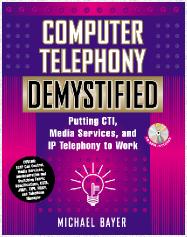 | ||||||
Overview | ||
| The goal of this book is to provide you with a complete insight into CTI and its underpinnings, regardless of what your final objective might be. In fact, the more you learn about the endless possibilities for taking advantage of telephony and CTI, the more you'll want to put it into practice!
Chapter 1 describes exactly what CTI is and is not. It provides context for the discussion of CTI and specifically relates CTI technology to the broader category of CTI solutions. This chapter presents the fundamental insights into why CTI is now maturing, and why it is likely to become as ubiquitous as the graphical user interface and other mainstream personal computing technologies.
Chapter 2 presents a collection of eight complete CTI solution scenarios in which people from different walks of life have applied CTI technology to improve their working and living environments. This chapter explains the CTI value chain, which reflects all of the different services and components that must be integrated to build functional CTI solutions. The CTI value chain provides the hierarchy around which the rest of the book is structured.
Chapter 3 presents a thorough introduction to the telephony concepts you need to know in order to take full advantage of CTI technology. This chapter presents a complete and universal abstraction of the world of telephone system technology. This simple abstraction is used throughout the book as a framework for easily describing any telephony product or capability.
Chapter 4 presents a thorough introduction to the concepts around telephony devices this includes physical and logical devices, device behaviours, device configurations, and referencing devices.
Chapter 5 builds on the concepts presented in Chapters 3 and 4 by showing how the elements within telephone systems of any size interact to provide the comprehensive range of telephony features and services commonly available.
Chapter 6 introduces the concepts of CTI as a means for observing and controlling telephone systems of any size. This chapter discusses how telephony features and services are accessed through a CTI interface, and presents the capabilities of a telephone system that are specific to CTI interfaces.
Chapter 7 presents the concepts of Media Services and explains how media processing resources are grouped and managed to generate and monitor media streams through media services interfaces.
Chapter 8 explains the implementation of telephony switching fabrics. It presents the concepts associated with switching fabric construction and documents various switching fabric implementations including POTS, ISDN and other TDM circuits, wireless, and voice over IP (VoIP).
Chapter 9 covers the current state of administrative interfaces for telephone systems including fault monitoring, configuration, performance management, security, and accounting.
Chapter 10 relates the concepts presented in Chapters 3 through 9 to tangible telephony product and service implementations. It describes the options that exist for those assembling a telephone system ranging in size from a single telephone to a private telephone network.
Chapter 11 presents the diversity of physical CTI configurations that are now possible and that will become easier and easier to assemble, given the maturation of CTI technology and availability of products based on standardized CTI protocols.
Chapter 12 complements Chapter 11 by presenting the diversity of software configurations that are available to support application development, CTI system integration, and user customization of CTI solutions.
Chapter 13 revisits the CTI solution scenarios presented in Chapter 2 and looks under the covers to explain how each can be implemented using the technologies explored in the book. | |||
© Copyright 1996-2004 For more information, contact Michael Bayer at Computer Telephony Solutions | |